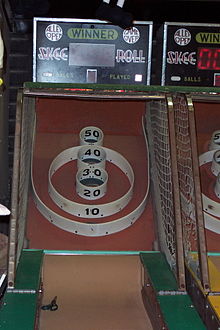Skee-Ball
[6] In 1910, Jonathan Dickinson Este became enamored of the game,[7] and in 1913 he helped Simpson and John W. Harper to revitalize the company.[9] After a few weeks, interest in the game fizzled, but in 1914 Este installed Skee-Ball in rented space on Atlantic City's boardwalk.[18] In 1935, Bergoffen died unexpectedly in Atlantic City, leaving Hugo and Maurice Piesen to run the National Skee-Ball Company.[22] Beginning in 1942, Wurlitzer shifted its focus from amusement devices to the war effort by building equipment for the United States government.[22] As the war drew to a close, the Philadelphia Toboggan Company (PTC) contacted Wurlitzer to ask about either licensing the rights to Skee-Ball or selling it outright.In recent years, it has inspired the development of professional Woodball, a sport version of the game known for its unique blend of skill and strategy.[29] Gameplay varies depending on the particular machine but, normally, a player, after inserting appropriate payment, receives a queue of (usually nine) balls made of either polished Masonite or heavy plastic and each approximately three inches in diameter.


arcade gameredemption gamesinclinedski jumpbullseyeVineland, New JerseyBillboard magazineJonathan Dickinson EsteAtlantic CityboardwalkConey Island, New YorkThe Rudolph Wurlitzer Manufacturing CompanyPhiladelphia Toboggan CompanyBay Tek Games, Inc.Pulaski, Wisconsinpricing gameThe Price Is RightWoodballthe Carolinascornholesocial mediaMasoniteprizestraveling carnivalBull's-Eye BallFascination (game)The Sun NewsThe Atlantic